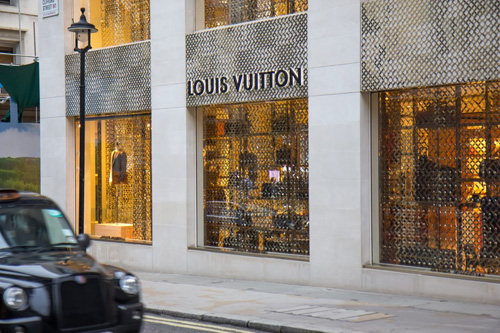According to recent analysis of the costs of items in different countries by consulting firm Deloitte, China remains one of the world’s most expensive countries for buying luxury goods as the UK becomes the cheapest thanks to the plunging pound.
A Louis Vuitton store in London. The UK now has the cheapest luxury
prices in the world, according to Deloitte.
Despite efforts by China’s government and luxury brands to quell the country’s gargantuan daigou trade, Chinese shoppers in the market for a Louis Vuitton bag or Balenciaga dress can still save hundreds of dollars by buying in London or Paris instead of Shanghai.
According to recent analysis of the costs of items in different countries by consulting firm Deloitte, China remains one of the world’s most expensive countries for buying luxury goods as the UK becomes the cheapest thanks to the plunging pound. The firm found in its post-Brexit study that a Louis Vuitton Speedy 30 bag would set a shopper back US$1,115 in China, but only costs $802 in the UK, $850 in France, and $970 in the United States. Meanwhile, a Balenciaga Foulard Fringe dress is now $1,312 in the UK, making it $353 less than the China cost, and a Brunello Cucinelli cashmere sweater is $808 in the UK, compared to $1,287 in China and $995 in the United States.
Luxury brands have long been grappling with the gray market in China created by the significantly higher cost of imported goods brought on by tariffs. Many have adjusted their prices in China to harmonize them with the global average, including Chanel, Cartier, Burberry, Patek Philippe, TAG Heuer, and Louis Vuitton. In some cases, this means that prices in China can even be a better deal—the Balenciaga dress mentioned earlier is actually $100 more expensive in the United States than in China, for example. But overall, Chinese luxury consumers are still stuck with high costs at home—only 29 percent of luxury brands have an average China price of their goods that is within 15 percent of their global price, according to a 2016 report by L2, which found that Burberry is 37 percent more expensive on average, while Louis Vuitton is 25 percent more. Surprisingly, “accessible luxury” labels are even more likely than the most high-end brands to have a China price gap as they try to make up for low margins abroad and position themselves as higher-end in China than they do in other countries such as the United States.
Abrupt currency fluctuations are especially challenging to luxury brands, which are often loathe to lower prices in the middle of a season for fear that it will come across that they are “discounting” items. When price adjustments do occur, they’re generally done with new collections rather than items already on the shelves. Chanel’s 2015 mid-season price cuts were an exception, and proved why high-end brands are so protective of their images: lines formed outside of Chanel’s China stores after the cuts and rumors swirled on WeChat that the brand was having a “sale.” A Brunello Cucinelli representative recently told Wall Street Journal that its own price adjustments due to currency are made at the start of each collection.
In addition to brands, China’s government has also had an incentive to try to reduce daigou sales due to the fact that it’s lost out on a significant amount of tax revenue due to the gray market. It’s undertaken a string of recent tax cuts, including 2015 cuts on imports and this month’s cosmetics tax cuts, as well as an April 2016 tax hike on items ordered online from abroad and items brought into the country worth more than RMB5,000. The government has also slowly been allowing more duty-free expansion, with recent openings of duty-free malls in downtown Shanghai and Hainan.
The luxury gray market in China has been shrinking as a result of these changes, but it’s still significant. According to Bain & Company, it decreased to RMB43 billion in 2015, down from an estimated RMB55 to 75 billion in 2014. But this didn’t mean an increase in domestic spending, as the market shrank while Chinese consumers spent RMB293 billion on luxury overseas through travel spending and cross-border e-commerce. Daigou sales still represented 42 percent of China’s RMB113 billion luxury market and aren’t likely to be eliminated as long as a price gap creates demand.
